Animal magic
3 June 2014 | Extracts, Non-fiction
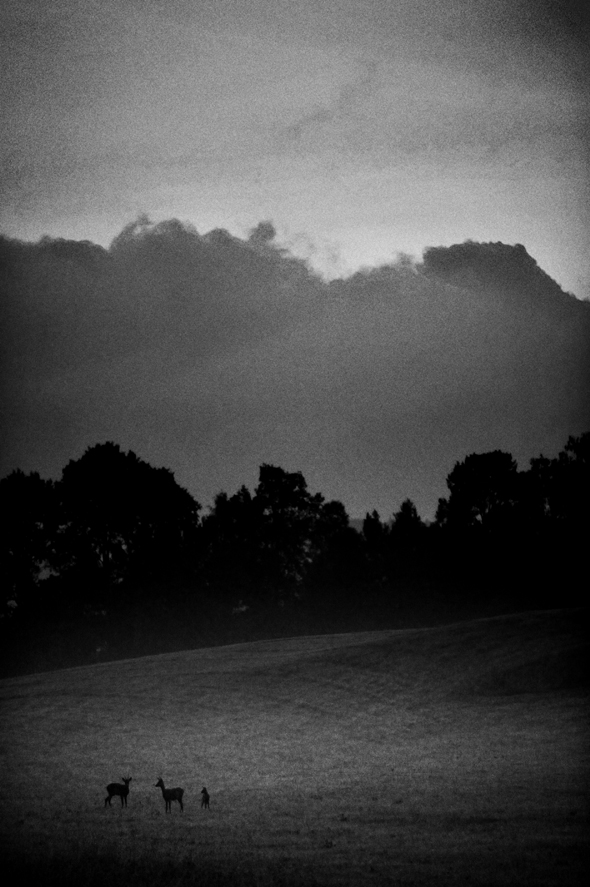
Roe deer, Sweden. Photo: Mats Andersson
A day in the life of an elk, of a lynx? Nature photographers venture into the depths of forests, in pursuit of the inhabitants – predator and prey, mythical and real. Photographs from Kohtaamisia (‘Encounters’), by Mats Andersson and Heikki Willamo, text by Willamo (Maahenki & Musta Taide [Black Art], 2014)
The feelings in our dreams. They well from depths – from those layers of awareness that the mind does not shackle. In sleep we handle and organise the events of our lives in a way which is impossible when awake, when we are conscious of ourselves and our limitations. That is why animals can come into my dreams as friends, equal partners, like me, and therefore I so often dream of having their abilities and skills.
When awake we think all the time. We think about past events and worry about the future or dream of something better. Very seldom do we live in the moment. Photographs are passing moments, often only a thousandth of a second long, but sometimes lasting minutes or even hours. In finished photographs the beholder can see much more – he adds his memories or dreams of the future. The picture-taking moment vanishes, something else comes in its stead.
According to our understanding only our closest related species can be aware of the past and the future, the others live in the present. What kind of dreams do they see? What does our dog dream of when its feet whip in a frenzy and weak barks follow one after another? Is it chasing a deer of which it earlier had the scent, or is it herdind reindeer, directed by its inherited instincts? It is difficult to believe that it is merely a question of reflexes.
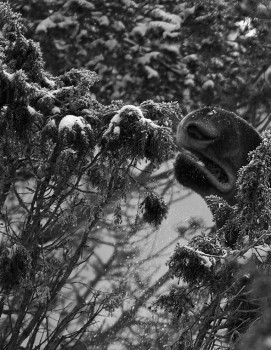
Elk, Finland. Photo: Heikki Willamo
I have closely watched the sleep of an elk and a fox. Their ears move, but I don’t know whether they then are really asleep, or merely resting with their eyes closed. Perhaps they hear sounds through their sleep, and with their ears check that nothing will surprise them. Perhaps they also can smell, eyesight is not that important for them.
I have also closely watched elks [Alces alces] lying down, ruminating. An hour passed, a second and a third one as well, and the animals just remained lying down. During those hours my thoughts roamed I don’t know where. They stopped only sometimes for a moment. Then I watched the elk, felt it close to me, and enjoyed what I was experiencing. Then the thoughts again escaped into the future. Questions and plans filled my head. When are the elk going to stand up? What happens next?
The elk just existed. They hardly felt bored, because existing is a major part of their lives. And further, they did valuable work, ruminating the morning’s meal, chewing it still one more time to catch all its energy.
The animal is deep in man. During our entire existence it has been important to observe other species as potential prey, dangerous predators, to read the events in the environment or to learn. Many an important invention has been made observing animals and studying their special characteristics – animals form a solid part of the development of our species.
We harbour a wish to observe animals. A wish to understand and to watch admiringly, to make pictures. Man has made pictures of animals for over thirty millennia. Painted, carved, hammered, sculptured, modelled…. In caves, on rocks, in clay, in bones and horns, in trees, in hides, in his own skin…. Pictures that stem from great respect and from the animals’ symbolic meaning in our life.
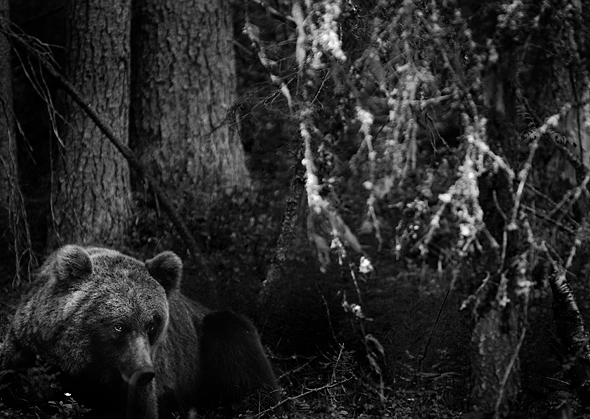
Bear, Finland. Photo: Mats Andersson
The first picture-makers were hunter-gatherers. Their apprehension of nature was animistic. They believed that everything had a soul or spirit; they did not lift themselves above the rest of nature. The hunting communities were dependent on the animals living in their surroundings, and the hunter’s attitude towards game was personal. It required mutuality and a certain treatment of the animals, both before killing them and afterwards. One had to secure the reproduction, rebirth and sufficiency of game through sacrifices and ritualistic treatment of prey. There were also taboos, forbidden words and a certain vocabulary connected with game during the hunt.
Animals were also tightly woven into the hunting communities’ spiritual world, and the hunter was able to keep contact with them both in sleep and when in trance. Thus he maintained a deep and personal relation to the game, of which every one was for him an individual. Such a close and deep relation with the nature that surrounds us is strange in today’s world, but I recognise something very close in it.
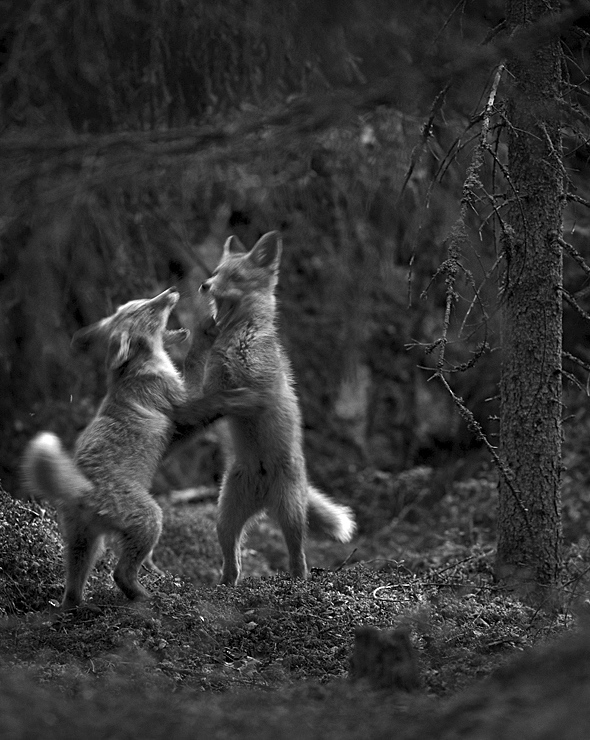
Fox cubs, Finland. Photo: Heikki Willamo
Some years ago I followed the growth of some fox-cubs for a couple of summer months. The cubs became close to me, they did not fear me at all. I was able to watch their daily life: the gradual expansion of their living space, their playing and their rest. After some weeks one of them died. I found it lying on its side on a cliff, as if it had only lain down for a while to rest. There were no external signs; disease had apparently taken it.
I have seen a lot of death in nature, and I hold it as a totally natural end of life. But now the deceased was one of the familiar fox-cubs. Death came close; a sudden ending of a young life. I wondered how the other cubs had reacted to the lifeless sibling, and how the mother. The fox hardly understands death, but something irregular it has to experience beside the dead family member.
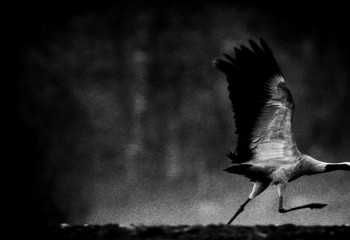
Crane, Sweden. Photo: Mats Andersson
I concentrated on the living and continued my association long into the summer. I laughed many a laugh, and experienced many wistful moments, when my own children’s early years came into my mind. We all have the same beginning. At first we hover around our mothers’ skirts, then we start exploring the world touching, smelling, tasting. The territory expands with the courage, for some more slowly, for others more rapidly. The journeys get longer, independence grows, and finally we break away totally. We become independent adults – men or foxes.
If one wants to encounter someone, one has to think of the individual. Not as a representative of the species, but just that individual with whom one stands face to face. At the same time one knows that one always also sees something species-specific. Four fox-cubs, four individuals: the bully, the brave, the timid and the fourth, which did not have time to show its character. Together they formed a total picture of a fox.
I have always liked the darker half of the day, and owls are deep in my mindscape. The soft whistle of the Pygmy Owl in a dusky forest, the – winnowing of the Boreal Owl in a moonlit spring night, the wild weddings of the Eagle-Owls in their cliff-castles – these are all experiences that leave their mark somewhere deep inside.
Because I know of the owls’ long history in man’s mind, or is it the other way around? They have always had their place, because they have something that appeals to us. Sounds in the night, round faces with eyes looking straight ahead – just like ours.
In the cave of Des Trois Frères in France there is also a carving [c. 25,000 years old] of a mystical mixed shape, with human feet and reproduction organs, the tail of a wolf, front paws of a predator, horns an ears of a giant elk, and an owl’s face with round, staring eyes. It might picture a shaman and his ability to take the shapes of his helpers on his spiritual journeys. Or perhaps it tells of a mythic beginning of time, when man and animals were one and the same.
In any case those ancient pictures in the caves tell of the owls’ importance in the ancient hunters´ understanding of the world, which perhaps originally lifted animals above man. That understanding of the world has dominated man’s mind for a long time, has changed only gradually in the flow of time, until the wheel of development some millennia ago started turning at an ever-increasing pace. History, which we possess, as people more or less unchanged, stretches over tens of thousands of years. It cannot have disappeared without leaving traces.
Science works to open our eyes. New amazing knowledge abounds in every field, but myths stay alive at the bottom of our minds. The spirits of nature and old mythologies have been replaced almost everywhere, but the majority of the world’s population still believes in the supernatural. Ancient sacred pictures have been changed to symbols of new religions, old rites and sacrifices to modern ones.
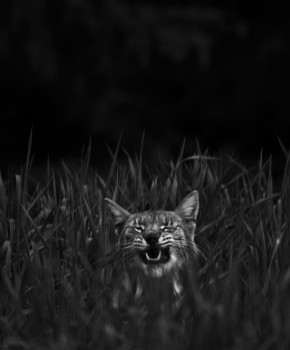
Lynx, FInland. Photo: Heikki WIllamo
The seven stars of the Big Dipper shine in the northern sky as part of the Ursa Major stellar formation. Cassiopeia forms the horns of the heavenly elk. The Milky Way is full of mythical animals. The Eagle-owl blows in the night – once, twice. The female replies with a gruesome squall from somewhere in the middle of some black firs.
The night is loaded with myths. Knowledge must make way for a moment.
![]()
Kohtaamisia (‘Encounters’), Maahenki Oy & Musta Taide, 2014. ISBN 978-952-301-015-4. Translation: Hans von Hertzen, Deilina Bishop
Mats Andersson is a Swedish photographer, Willamo lives in Finland. Inquiries / the English- and Swedish-language edition: heikki.willamo@kolumbus.fi
Tags: animals, Finnish nature, photography
No comments for this entry yet
